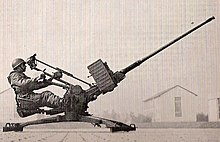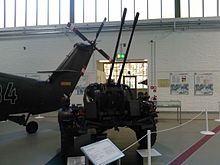Rh 202

The MK 20 Rh 202 , short for M achines K anone 20 mm Rh single metal, is a single-barrel machine gun mm in caliber 20th Developed in the late 1960s by the German armaments company Rheinmetall , the last models were produced in 1976.
development
The Ministry of Defense (MoD), represented by the Federal Office of Defense Technology and Procurement (BWB), commissioned early 1961 the German armaments industry with the new development of a 20-mm machine gun. Rheinmetall was able to prevail over Mauser with its design and was thus the winner of the order. This comprised a total delivery of 6630 pieces.
The basis of the new cannon was the Hispano-Suiza 820 L / 85, which was manufactured by Rheinmetall under license and used in the German armed forces with the designation MK 20-1 in the HS 30 and armored personnel carriers 11-2 . The further development Rh 202 from Rheinmetall fulfilled the requirements for effective combat against low-level planes, helicopters, soft targets up to 2000 m, hard targets up to 1500 m as well as safe handling and function as well as a short training period for the operators.
After several stages of development, during which various locking systems were tested, the test series began in 1966 at what was then the test center 91 Meppen. During the tests, the functional reliability of the weapon was tested in the presence of sand, dust, rain, cold and heat. The tests also included functional tests of the weapon without lubricant, the stability of the lubricant itself as well as investigations of the recoil forces, the barrel service life and the behavior of the weapon in the event of malfunctions. Troop trials ran from 1968 to 1969, during which more than a million rounds - including the newly developed APDS sabot ammunition - were fired under changing conditions. The technical acceptance took place in May 1969 and led to series production in 1970. Production took place at Rheinmetall in Düsseldorf and the second production facility at Mauser in Oberndorf.
The delivery of the twin flak began on October 12, 1972.
construction

The Rh 202 is a combined gas pressure loader and recoil loader with a rigidly locked support flap lock with a heavy lock head. The main assemblies are the barrel, weapon housing, locking device, spring slide, lock, trigger device, buffer, belt feeder, reverse brake and retraction devices, and cartridge ejectors. The ammunition is fed to the weapon using a double belt feeder (DGZ). This means that two different types of ammunition can be selected without reloading. The variant as field cannon FK 20-2 had a three-way belt feeder (DWGZ).
The Rh 202 has a locking bolt, which means that when it is loaded, the closing springs are tensioned and the bolt is held in its rearmost position by the bolt catching lever. When the shot is fired, the gas pressure is used to unlock and reverse the breech, to pull out and eject the case and the belt links and to tension the closing springs. The ammunition is also transported with the aid of gas pressure and is therefore independent of the weapon and locking system. The storage of the belt feeder in the carriage cradle avoids the influence of lateral belt feed forces on the weapon.
In addition, the weapon has a reverse brake and retraction device (RBVV). The recoil is limited to 550 to 750 kg by the strong spring mechanism and the muzzle brake .
The entire range of available ammunition in NATO standard - caliber 20 × 139 mm can be fired as ammunition . The standard ammunition in the Bundeswehr are explosive fire ( HEI ), armor piercing with tracer ( AP-T ), sabot ammunition ( APDS ), light blue training projectiles with reduced range and maneuver ammunition . The penetration rate of the APDS ammunition is 44 mm at 1000 m.
The weapon was designed in such a way that it can be dismantled for cleaning or maintenance without tools.
commitment
In the Bundeswehr , the Rh 202 is used as an on-board cannon in the Marder infantry fighting vehicle of the armored infantry and on the Wiesel armored personnel carrier in heavy hunter companies. This was made movable before with a single-axle special trailer and then on the Kraka . The Rh 202 also served as a BMK in the Luchs reconnaissance tank until it was retired in early 2009.
In the Luftwaffe, the Rh 202 served as a twin anti-aircraft gun LAAG for active airfield and property protection from 1972 to 1992. The hunter troops, the pioneers, the artillery, the army aviation troops as well as the supply and repair troops use the Rh 202 as FK 20-2 on the field carriage for ground combat as well as for anti-aircraft defense. During the troop trials, the field cannon was also loaded onto the loading area of a Unimog .
The navy used the automatic cannon for self-defense on its multi-purpose landing craft , tenders and frigates and on land-based in property protection. The use of the S-20 marine gun was replaced in 2008 by the MLG 27 from Rheinmetall. In the Kampfpanzer 70 project it was planned as secondary armament for anti-aircraft defense.
Furthermore, it is in the armored TH Condor , FIAT / OTO Breda 6616 and VCTP , a Argentine incorporated armored based on the marten.
Technical specifications
- Type: single barrel machine gun
- Function: combined gas pressure charger and recoil charger
- Caliber: 20 × 139 mm
- Rate of fire: 880-1030 rounds per minute
- Effective range: 2000 m
- Danger range: 7000 m
- Muzzle velocity: 1050 to 1150 m / s
- Weight (single ammunition feed): 75 kg
- Weight (double ammunition feed): 83 kg
- Total length: 2612 mm
- Tube length: 2002 mm
- Bullet weight: 134 g
- Recoil force: 550-750 kg
The types of ammunition used in the Bundeswehr can be found in the list of Bundeswehr ammunition .
Web links
Individual evidence
- ↑ a b c rheinmetall.de 50 years of the Bundeswehr: Rheinmetall Defense regained its old strengths in the 1960s: Gun development "made by Rheinmetall" ( memento of the original from November 19, 2010 in the Internet Archive ) Info: The archive link was automatically inserted and not yet checked. Please check the original and archive link according to the instructions and then remove this notice. , accessed October 31, 2010
- ↑ a b Hans-Peter Lohmann: Spähpanzer Luchs - The technical documentation of the weapon system. Motorbuch Verlag, ISBN 978-3-613-03162-3 , pp. 97-103.
- ^ Article on the website of the German Navy from July 4, 2008
- ↑ Proof of use on the Rheinmetall Defense website ( memento from December 20, 2010 in the Internet Archive )




